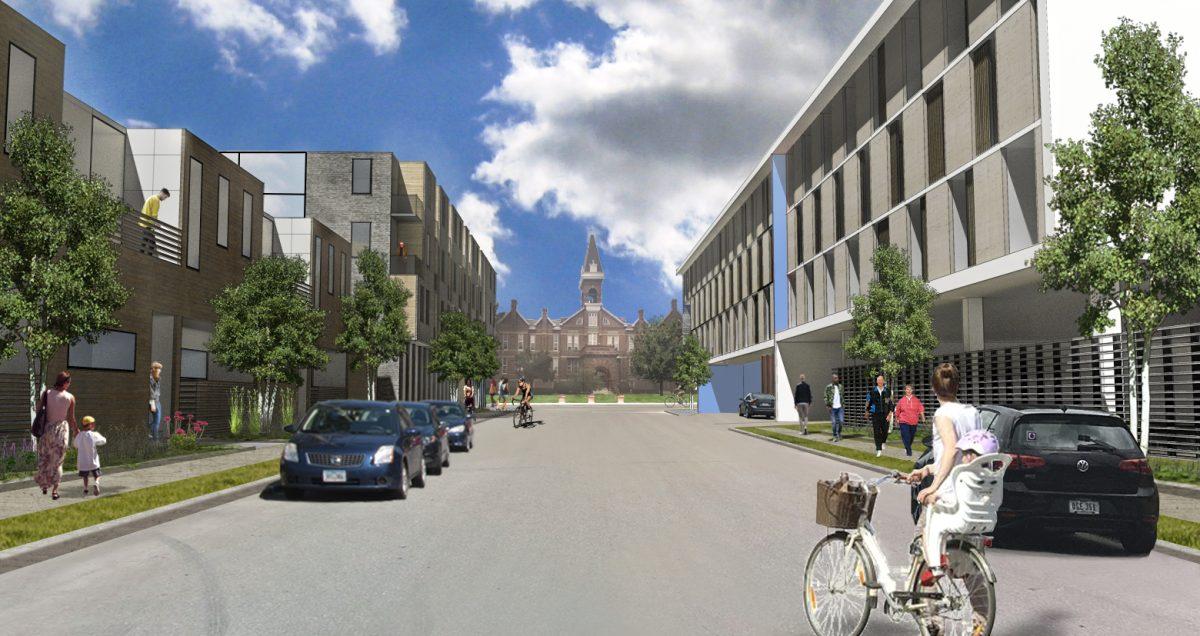Photo from Drake Press Release
Amid a number of construction projects on campus, Drake University is about to see a new one starting just across the street. The University Avenue project is expected to bring a hotel, new housing options and retail space to the Drake Neighborhood.
It all began when Drake agreed to sell two plots of land to Nelson Construction and Development this spring.
“Right now, these are parking lots,” Drake University President Marty Martin said. “They’re not attracting anybody to be here or to do anything in the neighborhood other than to work at Drake.”
Martin said Drake put out the call for proposals when the University decided to sell the land, specifying that Drake was most interested in a hotel.
“We believed there was a market for more hotels in this neighborhood,” Martin said. “Not just for people coming to do something at Drake, but for people just coming to visit Des Moines. We want more out-of-town visitors in this neighborhood, spending their dollars here, coming across the street to an event at Drake.”
Martin said the hotel would bring “its own activity” to the neighborhood and help make University Avenue more pedestrian friendly.
Drake ultimately sold the land for $1.5 million. Martin said Nelson’s project is expected to cost around $56 million.
Work on the land will begin next month. Martin said five Drake-owned homes currently occupy some of the lot.
“We put out a message to the community saying, ‘If you want one of these homes, you can come and get it and we’ll pay you $10,000 to take it away,’” Martin said. “Because our desire was if they can be repurposed, we want them repurposed.”
Two of the homes will be relocated in October. The other three will be demolished.
“That’s a really wonderful thing to celebrate anytime you can save historic homes and repurpose them,” said John Smith, vice president of university advancement.
Martin said Drake will maintain use of the parking lot until Nelson is ready to tear it up and start building. He said students shouldn’t be concerned about losing the lot.
Martin continued, saying that Drake has more parking spots than it sells parking passes for and that there are plenty of parking options.
“It’s not always the parking that somebody wants it to be,” Martin said. “At the same time, we are very interested in mitigating the need for people to need to bring cars to campus.”
Martin said that includes the bus pass, bike rentals and potentially bringing zip cars to campus.
While the project is expected to be a boost to the local economy, some residents have expressed concern about gentrification, the tendency for new developments to raise property taxes and push out low-income households who can’t afford to live there anymore.
“The real issue that goes to is affordable housing,” Martin said. “This neighborhood certainly needs to attend to more affordable, quality housing … that’s an issue that’s much bigger than Drake, but one we’re very willing to be a partner in tackling.”
President of the Drake Neighborhood Association Kristina Johnson said the project should add to the neighborhood.
“They’re changing a grass lot and a parking lot to housing,” Johnson said. “So as far as gentrification, it’s not really an issue for that.”
Smith said communication is essential as the project moves forward.
“As we get closer, there will become more actively engaged work with community members to get public feedback on certain parts to the aesthetics of the project,” Smith said. “Drake has always thrived to have open exchange and have open feedback between partners and the community.”
The University Avenue project is just the first in a number of projects to develop the land south of University Avenue.
“What we see is a wonderful opportunity for this private-public partnership between the University and Nelson Construction to make another substantive step in revitalizing the commercial and residential parts of the Drake Neighborhood,” Smith said.
Martin said Drake owns most of the lots between First Christian Church and Walgreens.
“We’re an urban campus, but it’d be nice to have more urban amenities close at hand,” Martin said. “We want things on the street that bring life to the street, to the neighborhood, to the campus. But also meet some needs. I’m hopeful that in the not-too-distant future we’ll be able to talk more about what that looks like.”







